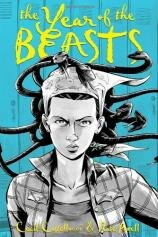Beauty and the Beast: Cecil Castellucci Talks Year of the Beasts
Bestselling YA author Cecil Castellucci tackles a dual challenge in her new book, Year of the Beasts, a hybrid novel and graphic novel. Here, she talks about the book and its unique format.
How would you describe your latest book, The Year of the Beasts?
It is two alternating stories told in prose and graphic novel. I think of it as a hybrid comic book.
Was combining prose and graphic novel into one book a particular challenge, more so than presenting this story strictly as one or the other? What made you want to tell this story in this format?
It was a challenge, but actually a very fun one. When I thought of this book, I knew that I wanted it to incorporate both prose and pictures because I know that sometimes telling a story with visual elements packs more of an emotional punch. Sure, I could write about a Medusa in high school who wants to be a girl again with words and it would be powerful, but it is so much more when you see her and her snakes. It’s so much more when as a reader, you can rest with a silent panel on the page. That’s what I love about writing and reading comics. There is this incredible way of slowing down and taking time when reading the narrative.
The book is a bit of a puzzle and part of the fun is that if you read just one half or the other, you get a complete story. But if you read both of them together you get the whole story and so much more. I wondered if I could do it and I think I did! I’m a big fan of trying to push myself and the boundaries of what I’m doing, or better yet to get into the interstices of form. I wonder how people who don’t read comics or who mostly read comics will marry the two elements of the book when they read it. For me, it makes sense. And I read both kinds of books very frequently.
Between your lead characters Tessa and Lulu, do you identify with one sister more? Why?
That’s an interesting question. I don’t have a sister, so I actually think that I relate to both Tessa and Lulu but in very different ways. I think that since the story is more from Tessa’s point of view, I identify very strongly with her jealousy and self sabotage. She’s infuriated by the unfairness of someone she sees as seeming to breeze through things with no trouble or having been somehow kissed by luck. But I also think that as easy as things might seem for Lulu, she is struggling at the idea of leaving being a little girl behind and becoming a young woman. For her, that is not easy. I remember that struggle very well. It’s a very hard leap.
How did you and Nate Powell meet and begin working together?
We met at the fabulous TCAF conference in Toronto. We were on a panel together about YA books. Him for Swallow Me Whole, which I am such a fan of. (I even own a page! Hanging in my living room!) and me for The Plain Janes/Janes in Love. We both come from indie rock backgrounds and so we got along like gangbusters immediately. When I sold this book to Roaring Brook, Nancy Mercado, our editor, had been looking at comic books to try to find a good match and Nate was her top choice. When she mentioned his name I was like, YES! YES! I LOVE NATE POWELL! LET’S ASK HIM! Luckily, Nate read the book and loved the concept and liked me and had the time to do it.
For The Plain Janes, I had written full script. DC-style. But for this book I wrote loose descriptions of action, emotional temperature, and dialogue and had thought that the artist would best know how to break it down page by page. It’s a fragile story and I felt that the artist would know best how to tell the story in a visual way. Nate, of course, is a master of that. He handed in thumbnails and then we all talked about it, he tweaked and then penciled, inked, lettered, and toned. I was blown away from the very get-go, from the very first character sketches. He’s just so fantastic. And I think it was a great way to work. Very collaborative. He really caught and got what I was going for and took it a million steps beyond what I hoped it could be.
The way the two stories parallel and play off each other is beautifully done. Did you write the prose and the graphic portions concurrently, or did one come first?
Thank you! Yes. I wrote them concurrently. And it’s funny. In my first draft, the prose and comics elements were swapped. The Medusa was prose and the regular high school was comics. And then I was like, what am I thinking!? THOSE SNAKES MUST BE ILLUSTRATED! So you know it was sort of like shuffling all the parts and trying to see how it could work. And as I said above, I really wanted it to make sense with just words, just images or both.
Even after all these years, Plain Janes has an amazing presence and resonance with readers. Are you surprised by how devoted the audience is for it and how far-reaching its impact has been?
Oh, yes. I love my Janes. I miss my Janes! I am glad that book one is back in print as of last winter on Vertigo (and I want to remind people that we complete the story in Janes in Love!). I think one amazing thing is the fact that so many of the girls who write me have been inspired to do art, be artists or just now notice street art all the time. There was even a girl who started an art collective in the UK that she called The Plain Janes.
I love, too, that it seems to be a gateway book for a lot of people (mostly women.) I can’t tell you how many times I get emails telling me that it is the first graphic novel that they ever read and they finally got how to read one and now they are reading other comic books and loving it. It’s too bad that the Minx line had to shut down. I often feel like we were a bit too soon and it’s a bit like the Oregon Trail. Some people have to go west first, and then they die on the road. But in the long run, the west is won! I think graphic novels for teens and for girls has really taken off and I am just so thrilled to have been a tiny part of helping that along. Also, that it got me writing comics. Sometimes I wish that Jim Rugg and I could have finished the whole four books so we could have completed the story arc that we’d planned. We were going to add a new Jane named Pain Jane! Total punk rock! Le sigh. But it is really great to know that the Plain Janes has a vibrant life of its own. I am so fiercely proud of the fact that people (girls, boys, women, men!) keep discovering the book and that they find something special in there.
In your comics work, as well as in your job at the Los Angeles Review of Books, do you see comics reaching more young adult females than previously? Is this a portion of the comics-reading audience that is expanding, in your view?
Yes. Absolutely. Like I said above, I think that graphic novels are being read by girls more and more. And there are more and more of them out there. Recent ones I’ve loved are Faith Erin Hicks’ Friends with Boys. Jen Wang’s KoKo Be Good. Kate Beaton. Every smart and sassy girl and lady loves Kate Beaton. I mean the graphic novel section in bookstores and libraries are exploding! Think, also, about how many YA novels are getting adapted as graphic novels. We are a visual culture and visual literacy is a part of how we interact with the world. There is no better way than to gain visual literacy than by reading comic books. I know that at the LA Review of Books we plan on highlighting great comic books for the young (and young at heart.)
What are you working on next?
I am happy to say another comic book! This one is for younger readers. It’s called Odd Duck and it’s about two ducks named Theodora and Chad. And, well, one of them might be odd. It’s illustrated by the fabulous Sara Varon, who is another one of my absolute favorite comic book artists. And I think she really helped to expand the comic book reading audience with her amazing book, Robot Dreams. Odd Duck will be out in spring ’13 on First Second. Prose-wise, I have a two-book sci-fi series coming out! It’s got aliens, humans, a space station and a war! Book one is called The Tin Star and that comes out in fall of ’13 on Roaring Brook.
-- John Hogan








